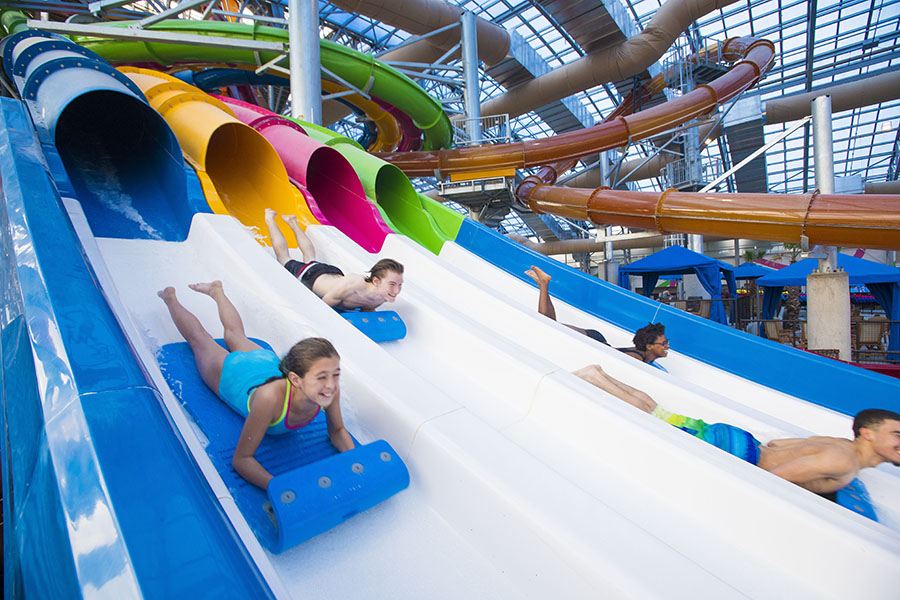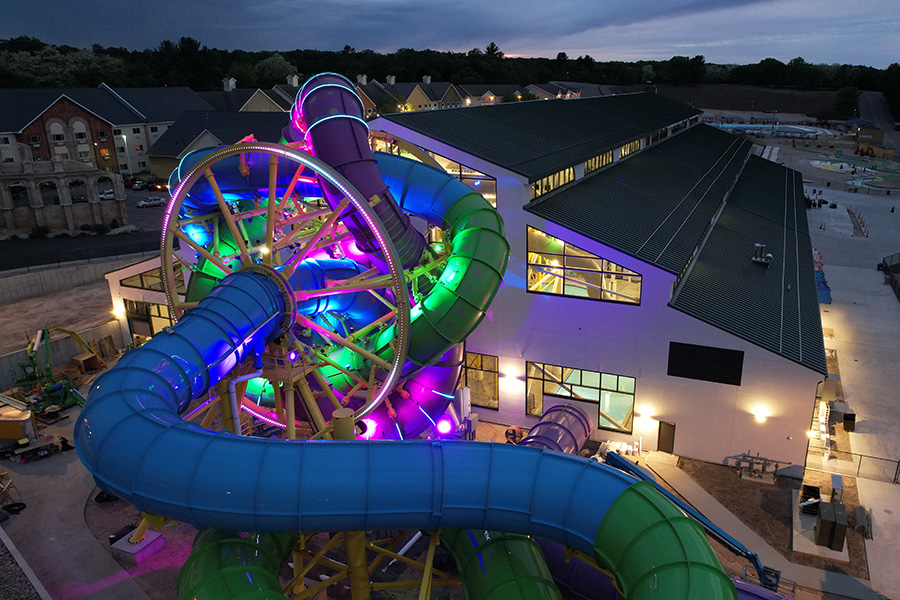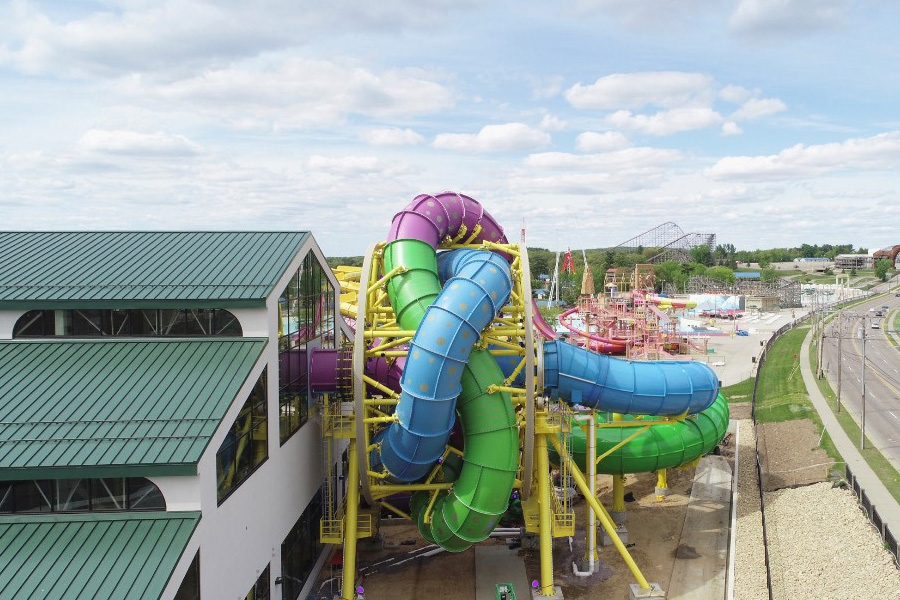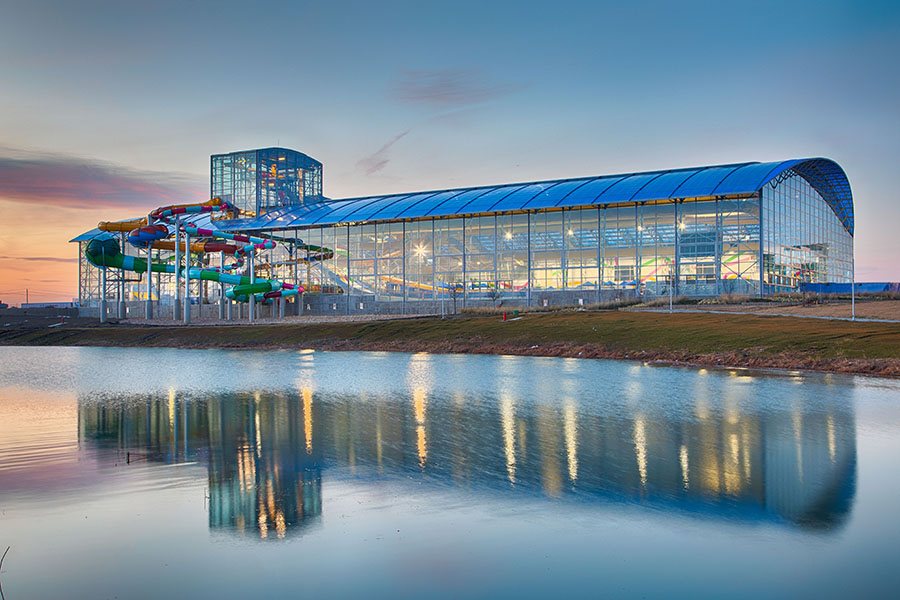How to Reinvent Your Indoor Water Park
ramaker insights
How to Reinvent Your Indoor Water Park
From water park recovery to . . . water park renaissance? Parks across the world are investing in ground-breaking attractions and big improvements to attract guests of all ages. Here’s how to keep your indoor water park one step ahead of the competition when planning a renovation or expansion.
Indoor water parks offer guests something that many other parks can’t: the idea that summer fun never has to end.
Think about it. Who’s worried about snowfall while sipping a frozen daiquiri at a swim-up bar? And who thinks about spring showers when speeding through a gravity-defying water slide?
Indoor water park fun is year-round fun, and for everyone. At least that’s the thesis for some of the most innovative parks. As water parks continue to recover from the effects of the pandemic, owners, operators, and managers are looking for creative ways to appeal to guests of all ages.
In this post, we explore how you can reinvent your indoor water park to increase capacity, improve guest retention, and drive profit.

Prioritize revenue-generating indoor water park attractions
Every music festival has headliners. Bands that organizers rely on to draw massive crowds of fans.
To drive attendance and revenue, today’s best indoor water parks have headliners, too.
While having a variety of amenities matters, indoor water park owners should try to prioritize attractions that improve year-round attendance. Think record-breaking slides. Or “dueling” rides that encourage repeat ridership. Attractions like these serve as valuable marketing opportunities for indoor water parks.
Few things capture the attention of potential guests like first-of-their-kind water slides. Take Medusa’s Slidewheel at Mt. Olympus Water & Theme Park. The first rotating waterslide in the Western Hemisphere, Medusa’s Slidewheel serves as a giant billboard for water park fun. The best part? The attraction, which was installed at Mt. Olympus’ indoor water park, operates year-round.
As the team at Mt. Olympus approached their indoor water park expansion project, they realized that there’s no one-size-fits-all path for water park improvements. That’s why Mt. Olympus Water & Theme Park focused on the whole family when expanding and renovating their indoor aquatic facilities. While Medusa’s Slidewheel headlines the park’s 22,500-square-foot addition, Mt. Olympus also invested in a large wading pool for young swimmers with a new activity area for families to enjoy.


Get creative to increase guest retention
Many indoor waterparks were designed with one demographic in mind: young families. But today’s facility owners have learned that water park fun is for everyone. The problem? A lack of usable space prevents parks from diversifying attractions and offering new amenities for visitors of all ages.
As you consider indoor water park improvements, ask yourself if your facility houses amenities for different age groups. For instance, does your indoor water park pair attractions for older folks like lazy rivers and spas with amenities for younger swimmers like zero-depth entry pools and tot slides? Do you offer options for teens like thrilling water slides and open swimming areas while also providing options for adults like lap lanes and swim-up bars?
Developing an indoor water park program that caters to multiple age groups isn’t always a matter of quantity. It’s about variety. Consider the Wild West Waterpark at the Wilderness Resort in Wisconsin Dells, Wisconsin. With over 70,000 square feet of thrilling slides, leisure pools, and other attractions, the Wild West Waterpark has become a staple of the water park capital of the world.
When the Wilderness Resort decided to renovate the iconic park, their operations team prioritized guest retention. Improvements include two new slides for thrill-seekers, a multi-level play structure for kids, and updates to the existing wading pool, tot pool, and pool deck.
The operations team viewed their aging waterslide towers not as a problem but as an opportunity. Instead of constructing new towers, they invested in new, leading-edge slides.
“Why should repair and maintenance be a burden? It is an opportunity to change a negative to a positive! That’s the attitude Ramaker’s most successful water park clients have embraced,” said Ramaker Aquatics, Civil, and Surveying Market Leader Daryl Matzke.
When looking to increasing repeat ridership, competition is a powerful tool for indoor water park operators. Both slide additions at the Wild West Waterpark are dueling slides—one is a dueling tube ride and one is a dueling mat racer. Attractions like these generally reduce one-and-done ridership and improve guest retention, as they encourage riders to go head-to-head, again and again.
Looking to strike the right balance of attractions and increase attendance at your indoor water park? Consulting with an experienced aquatic designer can help you determine which mix of attractions will best align with your budget and provide the most value for your park.

Improve operations and efficiency
Just as ground-breaking attractions capture the attention of new guests, energy efficiency captures the attention of owners and operators. Why? Reinventing your HVAC, lighting, and mechanical systems can reinvigorate your bottom line and improve guest experience.
The 24/7 operation of water treatment and air handling equipment can get pricey. In fact, energy costs typically represent the second-largest expense that water park owners face—with staffing usually being the largest. For this reason, operational costs must factor into any indoor water park renovation or expansion plans.
Operational improvements may not be as flashy as new water features. That doesn’t mean they can’t have a similar impact on revenue. Updating HVAC systems, installing more efficient lighting systems, and optimizing water pump performance can reduce facility maintenance costs in the long run. Keep in mind that finding the best systems for your park requires two things: time and the help of an experienced aquatic engineering team.
As energy costs increase, investing resources and effort in efficient system design now can mean saving on operating costs and utility requirements later.


Approach water park improvements with confidence
From groundbreaking slides to amenities for all ages of guests, today’s water park owners are finding new ways to increase attendance and deliver memorable guest experiences. But few of them are doing it alone.
As you consider renovating or expanding your indoor water park, make sure you have the right team in place. Experienced aquatic designers and engineers can advise on which improvements will align with your budget and add the most value. With intimate knowledge of the latest water park attractions and technologies, aquatic designers can help you stay ahead of the curve—and your competitors.
Design and engineering services for indoor water parks
Ramaker partners with leading water parks to deliver exceptional experiences that inspire guests to come back weekend after weekend and year after year. The firm’s continued involvement with record-breaking and cutting-edge water park attractions has positioned Ramaker as a trusted aquatics consultant for water parks nationwide.
Planning your indoor water park’s future? Start a conversation with our aquatic design team.



![An electric vehicle charger plugged into an EV. [TEXT] We need more EV chargers. Here's how engineers can help.](https://images.ramaker.com/wp-content/uploads/2022/08/01105302/ramaker-blog-cover_ev-chargers-engineering-150x150.png)